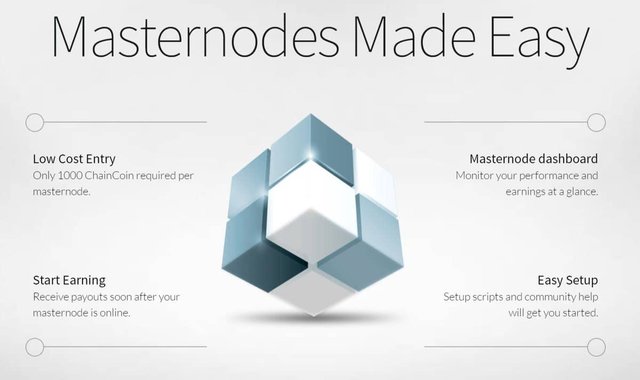How To Earn A Consistent Passive Income With Masternodes And Cryptocurrency

How To Earn A Consistent Passive Income With Masternodes And Cryptocurrency
Masternode crypto is the future of cryptocurrency investment. We’ll fill you in on everything you need to know about this fixed income investing opportunity with detailed information on masternodes coins and how to setup masternode chaincoins. More and more cryptocurrencies are turning to proof-of-stake and masternodes, you don’t want to be left out.
The cryptocurrency masternode is an incentivized member of an underlying blockchain network and fundamental to its function. Read on to answer the question, what is a masternode in cryptocurrency and why run a masternode? Believe me, you want to know.
Our top ten masternode list gives the latest info on the best masternode investments, new masternode coins and instructions on how to run masternode networks. If you want to make money in cryptocurrency without the hassle of mining or the risk of trading, masternodes are the answer.

What Is A Masternode In Cryptocurrency
If you haven’t already heard the term masternode and you’re mining cryptocurrency(or are planning to mine cryptocurrency or have any interest in mining or investing in cryptocurrency) you soon will. Masternodes tackle a growing problem in the cryptocurrency realm and are the next billion dollar opportunity for savvy investors.
Proof-of-Stake Versus Proof-of-Work
Before I go on it is important to understand the difference between proof-of-work and proof-of-stake when it comes to cryptocurrency. In either case the blockchain network is run by nodes. The nodes are the computers and servers that support the network’s functions. The nodes are rewarded for their support and receive newly minted or mined coins per the network they support. This is why they are called miners. The difference is in how the coins are mined, and what it takes to be a miner.
In Proof-of-work, the traditional method of verifying blockchain transactions, verification requires a lot of computing power. This is the protocol that powers networks like Bitcoin and Ethereum but it has some drawbacks, the number is insatiable need for electricity. Proof-of-stake is different because it does not require the same use of electricity, proof-of-stake (PoS) requires a miner to put down collateral, a stake, in order to participate in mining activities.in the case of PoW the miner effectively turns electricity into new coins, the case of PoS the miner earns a fee for providing computing power and liquidity.
Full Nodes Versus Lightweight Nodes
With either type of network, PoW or PoS, it is possible for a node to support the full function of the blockchain network or only the functions that it chooses. Full nodes are computers that implement the full core operating system of the cryptocurrency network (the Bitcoin Client for Bitcoin miners), as released by the network’s development team.
Full nodes engage, or may engage, in mining activity but are more important because they enforce blockchain protocol, support the full function of the blockchain and send new information out to the network. The full nodes are the means by which the cryptocurrency network maintains its integrity.
To be a Bitcoin miner you have to run the full Bitcoin Client but you don’t have to support distribution of the blockchain to the network. Both functions cost money but only one, mining, results in gain for the owner of the node. Nodes that only support mining functions are called lightweight nodes. The real difference between a lightweight node and a full node is that the lightweight node may mistakenly, from time to time, validate an improper block on the chain and create a stale or orphan block.
Stale or orphaned blocks are blocks that are later invalidated and are essentially a waste of time and resources. Full nodes will never improperly validate a block because they download, verify and distribute the full block in accordance with blockchain protocol. The lightweight nodes only download enough info perform the mining functions.

The Problem With Proof-of-Work Blockchain Mining
Aside from the cost of operating the PoW nodes there are some problems arising from them that are causing concern. The first problem is centralization of mining. Countries like China (about 80% of global hashrate) and the Czech Republic (about 10% of global hashrate) could have undue influence on the Bitcoin network (or any cryptocurrency) simply due to their control of global mining capability.
An even greater problem, however, is the functionality of the network. Full-nodes are computers and networks that support the full functionality of a cryptocurrency, not just mining. As cost of mining rise, and miners turn away from full support and toward mining pools, the amount of computing power focused on supporting the cryptocurrency networks becomes impaired. In proof-of-work blockchains most of the computing power is focused on hashrate (mining) and not the blockchain’s functionality. Because cryptocurrency mining pools are focused on mining activities and making money, not altruistic support of blockchain technology, this problem will persist unless a solution is found.
The cryptocurrency masternode helps alleviate the issues by incentivizing full support of the network. They are an advanced form of PoS cryptocurrency with a tiered reward system. The terms will vary from cryptocurrency to cryptocurrency but all include a mixture of lightweight nodes (stakeholders) and full nodes (masternodes). Both stakeholders and masternode owners must put up a stake to make the network function, the difference is size and reward. Masternode holders put up a substantial amount of collateral, computing power and memory in order to support the full functionality of the underlying network and receive the lion’s share of mining rewards.

Important MasterNode Information You Must Know
All masternodes cryptocurrencies are based on blockchain technology but not all blockchains use the masternode system. All masternode cryptocurrencies use the proof-of-stake method of block generation which is a much more eco-friendly means of operating a cryptocurrency network.
Proof-of-stake cryptocurrencies require miners to put up a stake (along with a significant amount of computing power and memory) which is then used to power the network. Stake holders earn fees for facilitating the blockchain and the stake is a means of keeping them all “honest”. The idea is that a miner will be less inclined to meddle with network function or force a hardfork if they have “skin in the game”.
Masternode cryptocurrencies create a two-tier system in which some nodes do different work than other nodes and require a larger stake to ensure proper function. The masternode supports full functionality while the lightweight mining nodes only support block creation and transaction verification.
When relating masternodes to traditional investing they tend to function more like bonds than stock. They are a type of fixed income investing that requires a loan, the stake, which is used to fund the cryptocurrency network. The lender earns a fixed rate of return in compensation for the loan, as well as retaining the original amount. When compared to traditional forms of cryptocurrency mining masternodes provide a better and reliable source of income.
- Increased privacy. Transactions are conducted within the masternode’s sub-network for initial verification instead of being transmitted across the entire network. This keeps data localized and away from public scrutiny. In privacy oriented blockchains the masternode can serve as guarantor of a transaction precluding the need for additional identification. The masternode also serves as a “coin mixer” so that tokens are effectively “laundered” before being sent on their recipients.
- Transaction Speed. Transaction speeds are enhanced because the masternode system helps control the flow of traffic. Masternodes serves as branches of bank that can perform all the functions of the main bank without the need of additional verification. The masternode then bundles all of its transactions and delivers them in bulk for inclusion in the next block.
- Governance. Masternodes have more say in the governance and operation of the blockchain network. In most cases the masternodes are treated as equal owners within the development community and are allowed to make proposals, cast votes and determine the direction of development and/or use of funds.
- Budgeting And Treasury System. Every cryptocurrency has a development team and plans for expansion, and that means cost. The masternode system usually allows the allocation of funds to the development and growth of the network according to the consensus of member nodes. A portion of each block reward is earmarked for the community coffers and that money is used in accordance to community direction.

Why run a masternode? For Regular, Consistent Return
Masternodes have a lot of power within a cryptocurrency universe. They are the glue that holds the network together. Without them there is no framework for the network to operate, and no guarantee transactions will go through.The mining nodes (stakeholders) do a lot of the heavy lifting but it is the masternodes that do all the real work. The masternodes enforce the highest standards of the cryptocurrency network by requiring strict adherence to core protocols issued by the development team. This is why the masternodes are incentivized and that means big opportunity for investors who want to cash in on the exponential growth of blockchain technology.
The difference between stakeholders and masternode owners always boils down to one thing; the amount of skin in the game. A stakeholder may only have to invest a few hundred dollars while a masternode may cost thousands, or tens of thousands of dollars to set up. In most cases the fee earned by the masternode is far greater than that earned by the stakeholders (the miners). The miners produce the blocks and generate the block reward but the masternode operators get as much as 90% of it, depending on which network we’re talking about.
In terms of ROI, your return on investment, masternode are by far the better choice. The average ROI on our top ten list of master node cryptocurrencies is well over 100% but be warned, those returns won’t last long.
The return on a masternode investment is directly related to cost of entry (how much you have to put up relative to the cost of purchasing the appropriate cryptocurrency) and the number of masternodes on the network. This means as more investors flock to this emerging alternative investment opportunity the less it will yield because there will be more nodes to share rewards with.
Masternodes usually pay out on a rotating system. All masternodes are put on a list and paid out one by one until each are paid in turn. There are other factors governing payouts that can vary from one masternode currency to another so be sure you understand how each works before making your choice. Cryptocurrency with less masternodes will pay out more frequently (sometimes two or three times per day) while the largest and most established coins pay weekly or monthly.
The upshot of masternode style cryptocurrencies is that anyone can run a masternode. The downside is that there is a barrier to entry (masternode stakes may run in the tens of thousands of dollars) but even that is a good thing for serious investors. The cost of entry will keep hobbyists out of the market and helps ensure consensus among node operators.

The Things You Need To Operate A MasterNode
1 - A Stake.
The amount of money it takes to stake a masternode varies from token to token. Dash, the first to use the masternode system, requires 1000 units which equates to $240,000 with DASH/USD trading at $240. This considerable sum buys your trust but is also the key to unlock a large and profitable mining operation. The fee structure is different from network to network but all provide a decent monthly or weekly return. Be sure to calculate your expected ROI (return on investment) including the cost of hosting before committing to any one of them.
2 - Hosting.
You will have to host your verifiable escrow account (the wallet where you hold your masternode stake) 24 hours a day, seven days a week to ensure that your masternode network remains operational. This means equipment and electricity that you can pay for directly (self hosted) or utilize a hosting company instead. Cloud services like VPS provide all the computing power you will need. A VPS is a virtual private server, it is a cloud-hosted operating system you access through the web that functions just like a desktop computer. An even better choice would be a third-party hosted masternode similar to hosted mining services. Don’t forget to include this cost in your calculations for ROI.
3- An IP Address
You will have to have a connection to the Internet and a dedicated, static, IP address. This means at the very least an account with an ISP. Depending on where you live this may not mean much, Internet is free or very cheap in many parts of the world, but for some it will produce an additional charge that will affect the ROI.
4- Ample Storage
In order to perform the function of a masternode you will have to have ample storage. The client protocols for cryptocurrencies can take days to initially download and that does not include all the information on the blockchain, and all blocks yet to be formed.

Dash Is Number One On Our Masternode Cryptocurrency List
Dash, a top fifteen cryptocurrency by market cap, was the first to adopt the masternode system. They allow new masternodes with a deposit of 100 Dash units and have been paying out substantial sums to the MN operators. The official website, Dash.Org, give lots of stats on how the masternodes are performing but it’s hard to find info on how to become one which is odd, masternodes are the core of their technology. Good thing we’re here to help.
- The masternode enables instant, anonymous transactions because it acts as an escrow account and guarantor of payment at the localized level. The masternode operator recoups costs when it verifies transactions between other masternodes on the macro level.
Basically, there are two kinds of wallets in the DASH network, the regular wallet and the full wallet. The regular wallet can perform all the tasks associated with Dash except provide liquidity or ensure instantaneous transactions.The full wallet handles those functions.
The Dash MasterNode System requires a deposit of 1,000 Dash tokens(along with a dedicated server operating 24/7) which are used to provide the collateral that fuels the network’s superfast financial applications. The tokens can be held in any Dash enabled wallet so long as they are visible to the network and never fall below 1,000 Dash. If at any time they do the Dash masternode becomes inactive.
Here are a few quick stats to help illustrate the numbers involved in masternode mining. There are more than 4,300 operational Dash Masternodes each with a full copy of the Dash blockchain. The masternodes earn half of all tokens mined by the mining community and receive payouts every week or so depending on mining conditions and difficulty level. A recent payout was 0.213142 Dash per day for a total payout of 1.673 dash which annualizes to 78 Dash or $18,671.24, not bad for a $240,000 investment (about 7.5%)
There are two types of masternode solutions for the Dash network, the hosted or the self-operated. The hosted masternode is the easiest because it means someone else owns the equipment and operates the node, all the investor has to do is put up 1,000 Dash. If this sounds familiar it should because it is the same setup as hosted mining for a PoW blockchain; you support the network with your money and make a return for the risk. Hosted masternodes include a small fee that can cut into profits but in our opinion that fee is negligible compared to the return. If you aren’t in to tech and hosting your own servers this is the method for you.
Self-operated masternodes are the second form and are much more difficult to operate but not impossible. If you have any amount of interest and tech savvy you should be able to get set up with a relative amount of ease, if not refer to the paragraph above. The hardest part of setting up the MN is using Linux and that is uniform across the MN network. Dash recommends the Ubuntu 16.04 LTS operating system for best results. They also recommend a VPS cloud service (more reliable than a home based operation) but you can set up your own servers if you want to. They also recommend a 2 ghz CPU with 2 gigs of RAM, 16 gigs of storage and a terabyte of bandwidth every month.
Dash developers estimate that normal VPS servers will be able to run masternodes on the network until the block size reaches 20 Gigabytes. At that time the use of GPU’s and ASIC’s (specialized mining rigs) will be required. The blockchain is about 6.71 Ghz at the time of this writing providing a window of opportunity years long that investors can take advantage of.
Dash MN operators are able to participate in voting on issues pertaining to the operation and growth of the network. Proposals and matters to be voted on are listed in a forum, all confirmed MN operators get one vote per MN.
DashCentral.org is a non-profit service helping masternode miners monitor their systems and ensure success. They also make it easy to keep up with and vote on all the latest network proposals. All you have to do to participate is open (and set up) a masternode wallet and enter the IP address on the sign-up page.

Hosted MasterNodes For The Dash Network
There are quite a few hosted masternode services for the Dash network. They require a small fee but will handle all the work of setting up and maintaining the masternode, all you have to do is put up 1,000 Dash. The good news is that you don’t have keep your Dash in a web-based wallet. a hardware based wallet you keep at home will do so long as it is viewable to the network. Your hosted masternode will continue to function so long as your 1,000 Dash are in the wallet..
#1 Dash hosted Masternode, Masternode.me
Masternode.me is a masternode hosting service operated by MooCowMoo. I know the name is odd but this handle belongs to one of the Dash Core developers so don’t judge too soon. The site is designed to facilitate the effortless creation, management and monitoring of Dash masternodes but be warned, there is still quite a bit you have to do to get the system set up.
What does Masternode.me do? They host the servers and memory space required to run a masternode. Users need to send a 1,000 Dash deposit to a new address of their choosing, then use that address to set up hosting through the Masternode.me website. Hosting costs a flat rate of $35 per quarter, quite low, and is a small charge compared to the average monthly payout.
Features of masternode.me include locked-down hosting, security and self-management. Locked-down hosting means the servers employed by masternode.me are used solely for Dash. No other services are running, so there is reduced chance of compromise. Nothing is stored online that could compromise your funds, as long as the wallet is safe the money is safe.
After you verify the masternode deposit and pay your first fee you get access to a suite of management tools. The tools inform you when and if a user-initiated update is required, when payments run and monitoring of the VPS hosting your account.Support is available through multiple channels. The easiest method is direct contact with moocowmow at [email protected]. If that doesn’t work you can find help at Twitter, Reddit and the Dash Forum.
#2 - DashMasternode.io
The first thing you will notice about DashMasternode.io is that it has a much friendlier and aesthetically pleasing website than Masternode.me. DashMasternode is a webbased hosting service operated by Splawik21, another well known handle from the Dash Core community. The site facilitates hosting for the fee of 0.1 Dash per month, or about $24 with Dash near $240.
#3 - Node40 Dash Masternode Service And More
Node40 is another masternode service. Unlike DashMasterNode.io and Masternode.me this one is operated by a person with a name and offers more than just MN hosting. Node40 will also help with voting and tax compliance.
Node40 Hosting is the branch handling incentivized blockchain management. They will host your Dash masternode and provide the tools to monitor and assess the operation of your MN. The service uses an installation wizard to help you every step of the way, your 1,000 Dash are held in a secure wallet of your choice and payments are made according to the Dash masternode payout plan.
Included with every masternode is access to Node40 Balance. Node40 Balance is a software package designed to monitor, track and record all of your cryptocurrency transactions. It will list all profits and losses by token and value so that you only pay the taxes you owe and not a satoshi more.
The fee for Node40 is low and comes on a progressive scale depending on how you want to pay. The base fee is 0.3456 Dash monthly and includes Node40 Balance, if you decide to pay quarterly or all at once there is a discount.
Node40 is founded and operated by Perry Woodin and Sean Ryan. Perry Woodin is an early investor in Dash and a long-time tech developer, Perry Woodin is a software developer whose worked with major corporations and governments. They created Node40 to fill the gap created when Dash was launched and are in business to help you set up a masternode.
#4 MasternodeHosting.com Has Variety For Serious Masternode Investment
Masternodehosting.com is a bare bones service with one thing going for it; it has variety. Operated by yet another Dash Core team member Masternodehosting.com supports hosting for over a dozen different masternode style cryptocurrencies. The fee is about $20 per month($30 for Dash) but will vary depending on cryptocurrency.
How To Set Up A Dash Hosted Masternode
Setting up the hosted masternode is relatively easy. I suggest choosing a host first and contacting them before getting started.
- Create a Dash wallet. You can use the Dash Core wallet or one of several other wallets. They recommend a hardware based, not a web-based, wallet for added protection. This must be a new, unused, empty wallet when you start.
- Download the Dash Masternode Tool.
- Buy 1001 Dash on an exchange where Dash is listed. You need to buy 1001 Dash to ensure you have the processing fee when you transfer your stake to the newly created wallet. You don’t want your stake to come up short, it needs to be a single transfer of 1,000 Dash into a new wallet address. The Dash Core Wallet will let you create as many new addresses as you want.
- Transfer your 1,000 Dash stake to the new, unused wallet. Wait until you get 15 confirmations, the requirement for a masternode.
- Send the masternode address to your chosen hosting provider (the address of your wallet containing 1,000 Dash) and they will send you a masternode IP address and private key to set up the Dash Masternode Tool.
- Enter the IP address, key and wallet address into the Masternode Tool and begin masternode mining.

fintech icon on abstract financial technology background represent Blockchain and Fintech Investment Financial Internet Technology Concept.
The Important Masternodes, And What You Need To Know About Them
Dash is the first and most important of the masternode cryptocurrencies but it is not the only one. There are about 400 masternodes crypto investors can choose and new ones on the horizon. Our masternodes list is the best place to get started because we rank the top masternode coins 2018 and provide the information you need to make a smart investment.#2 - PIVX (PIVX) -
PIVX is the number 2 masternode cryptocurrency by market cap (relative to Dash) and in the top ten in terms of trading volume. To put this rank into perspective let me tell you PIVX market cap is only $1.3 million, about 1% the size of DASH. At its peak in late 2017 PIVX was trading at $14.00, it now trades for about $1.85 and offers a 7.15% return for masternode investors.There are about 1,700 nodes in operation, less than half that of DASH, but that risk is mitigated by the minimum investment. PIVX masternodes are set up with 10,000 PVX which equates to about $18,000 at current prices or less than 10% of a DASH masternode investment. The reward is paid out every day or so which makes it an attractive choice for investors looking for quick returns and instant cash flow.
The PIVX network is all about privacy. It is intended to facilitate instant, private, verified transactions in a decentralized manner. They explain themselves in a manifesto which gives them a bit of an edgy feel. In it they state that privacy is non-negotiable, freedom is everything and that governance of the Internet must advance at the same pace as the technology.
PIVX is a proof-of-stake cryptocurrency based on the Bitcoin 1.0 protocol. It utilizes a structure that requires node operators (lesser nodes, miners) to keep their wallets open at all times in order to create a more stable infrastructure (less down time, constant or increasing number of nodes, liquidity). What this does for the node holders is create an environment in which everybody has to participate equally in order to be rewarded equally.
The masternodes are further incentivized to support the network and receive a higher reward than the lesser nodes (who are not required to stake as much). The masternodes run the full wallet which provides coin-mixing (for privacy protection), instant transactions and decentralized governance. Masternodes are also able to vote on core community and development issues and participate in the future of the network.
On an interesting side note, PIVX did not have an ICO to get started. It was started as a proof-of-burn concept in which pre-mined coins were destroyed in a public and totally unrecoverable manner. This process created an equal value of new tokens which are now labeled PIVX. In addition to PIVX tokens masternodes can be staked with zPIV, Zerocoins that have been converted to PIVX, more on that later.
Because PIVX is proof-of-stake and not proof-of-work it requires less computing power but you will still need some. You can set it up yourself if you know how to use a Linux server or Raspberry Pi, if not a hosted solution is probably best. Coin-server and Eclectic.IO are the top two recommended but there are others. These will cost you about $0.30 per day in PIVX or other currency and provide good value.
#3 - SmartCash (SMART) -
SmartCash is the number three masternode cryptocurrency by market cap and provides an eye-popping 50% masternode ROI. The return is due primarily to the low price of SMARTand at the time of this writing, only $0.0909, which makes it attractive from a speculative perspective. The minimum stake is only 10,000 SMART which comes out to less than $1,000 at these prices. Assuming the network gains popularity the SMART coins could see astronomical gains, in the meantime investors can cash in on the masternode return.
Market cap on this coin is just shy of $100,000 which puts it level with PIVX. In terms of trading volume it is a top five token which means there is interest from the market. Regarding the network and the number of nodes there are more than 13,000 of them making it the most widely supported of all masternode networks. Rewards come every 8.2 days so this is not a great choice if you are looking for instant returns, on the flipside the reward is about 130 SMART every payout.
SMARTCASH is a user-oriented, merchant-focused cryptocurrency network. It has a decentralized governance system (the masternodes) that ensures stability within the system. Their goal is to create the most nimble, user-friendly, cross-token exchange system and are aggressively working toward that end. They base their design on a hive mentality so it is not exactly the same as a Bitcoin or Dash blockchains.
The network uses a system of SMARTRewards to incentivize long-term holding of the tokens and support price gains. This means that any wallet holding more than 1,000 SMART (stake holders) will be rewarded each month with a portion of block-rewards budgeted to that purpose.
The SMARTNodes are what they call their masternodes. The SMARTNode requires 10,000 SMART and getting them may be the hardest obstacle to overcome. The coin is not yet widely supported by the major exchanges but it is listed and the number of exchanges is growing. After getting the tokens all you need is a computer with a SMART wallet and a VPS server on which you can install Ubunto. It only takes 1 GB of RAM and a 20 GB drive which is not expensive to operate. The SMARTHive system allows anyone holding SMARTnodes to vote on proposals submitted within the community.
Hosted masternode services are available from masternodehosting.com and other sources. The SMART website cautions investors from using hosted services that require you to give up your token keys (the proof of ownership) such as shared Smartnodes (where you are not required to put up the entire stake).
#4 - Syscoin (SYS) -
Syscoin is the number four masternode crytpocurrency in terms of market cap and only a step behind SMARTCash at about $88 million. In terms of trading volume Syscoin is ranked second among the masternode currencies and nearly double the third ranked SMARTcash. It yields about 11.25% and requires a minimum investment of 100,000 tokens. The good news is that the tokens have been trading near $0.165 each which puts the investment stake for masternode operators at $16,500.
The average reward frequency is less than one day making this a good choice for instant, steady returns. The only downside is that there are only about 1,100 nodes in operation, one of the less stable networks on our list. Regardless, it is one of the more promising blockchain applications I’ve encountered and a very interesting investment.
Syscoin is a cryptocurrency network that facilitates near-zero cost financial transactions between businesses allowing secure transference of goods, assets and data. With it you can sell a single item or build up a business that uses Syscoin to enable transactions. Features include price-pegging to a set currency, arbitrage and escrow accounts which make it an attractive solution for financial related businesses.
What makes this token unique, and mitigates the low number of masternodes, is merge-mining. Because it operates on the same SHA-256 hashing algorithm as Bitcoin and many other cryptocurrency it can piggyback its mining needs on top of the BTC network for added security and power.
Minimum requirements for hosting a masternode, aside from the stake, include 2 GB of memory, 40 GB of disk space, Ubuntu Linux OS and a fixed IP address hosted on a cloud service like Microsoft Azure. Setting up the masternode is relatively complex so be prepared, otherwise look into a hosted masternode at Masterminer.com or other service. In order to set up the masternode you will have to open a wallet with exactly 100,000 tokens so be sure to buy a few extra just in case
#5 - ZCoin (XZC) -
ZCoin is ranked 5th in terms of market cap and trading volume; the entire network is worth about $87 million and trades about $2 million per day. At $16 it is also one of the more expensive tokens on this list but that is mitigated by high masternode ROI and a low stake. The ROI is pegged at 27.50% (relative to XZC) and requires only a 1,000 token deposit. At current prices this makes each masternode worth about $16,500 and consistent with most masternodes on our list.
The network is maintained by more than 3,300 nodes so it is well supported. The drawback is reward frequency, about 19 days, so it is not a good choice for regular or instant cash-flow. As the network grows, the more masternodes there are, the longer the time between payments will be so keep that in mind. The upshot is larger payments when you get them.
ZCoin is a cxryptocurrency based on the Bitcoin blockchain protocol with one major difference, it seeks to fix the anonymity problem associated with Bitcoin. Bitcoin is not truly anonymous because the same data-mining techniques that work with Big Data sets from social media will work with BTC data. ZeroCoin, in effect, was meant to be a money-laundering extension of the BTC protocol but has evolved into its own currency. The beauty of it is that any cryptocurrency can use the Zerocoin protocol (like zPIVX) to facilitate anonymous transactions.
Znodes, the masternodes that support the ZCoin network, require a basic understanding of Putty and Linux OS, and comfort with command line commands during set-up. If not, don’t worry, there are a number of hosted providers that can help you. MasternodeHosting and Nodesupply are two well regarded providers. Minimum requirements, in case you decide to go it alone, are 1 GB of RAM (2 is better), 20+ gigs of free disk space and a stable, 24/7 connection to the Internet (like all masternodes).
#6 - Ion (ION) -
Ion is another up-and-comer in the masternode space. It is a platform for gaming, gamers and developers on which users can earn real money (pay-to-play is rewarded with real cryptocurrency).
This masternode network is a top-ten token in terms of trading volume and market capitalization but still on the small side regarding nodes. There were only 520 masternodes in operation mid-2018 making it one of the smaller networks on the list. This risk is rewarded with a higher than average (relative to traditional fixed income investing) ROI of 29.16%. The stake to set up the masternode is pegged at 20,000 IONs which, at $0.90 per token, comes out to about $18,000.
One of the benefits of the ION masternode network is the reward frequency, a mere 8.5 hours, which will result in instant, steady returns for investors. Based on past results a masternode operator can expect to receive about 8,100 Ions over the course of a year or roughly $438 monthly.
What is Ion, exactly? Ion is a cryptocurrency network developed for the gaming industry. It is designed to facilitate the use of altcoins through games. It is a fully featured platform for gamers and developers who want to earn or reward in-game use with cryptocurrency. The players can download games from the Android and iTunes app stores then buy lives with ION tokens they buy through the Ionomy wallet. The wallet is free, all you have to do is sign up, and with it you can exchange fiat for IONs and IONs for Electrons and Atoms (game friendly tokens), or set up a masternode.
If you are interested in fixed income with cryptocurrency but don’t want to put up $18,000 (or more if ION price goes up) you can be a “staker”. Stakers put up smaller amounts for short periods of time and receive 15% ROI in return. When I was reviewing the site the minimum investment was 500 ION for 90 days.
Creating a masternode with ION is the easiest of any I’ve seen and it’s because this network wants you to put up a stake(mining, proof of stake network). All you have to do is set up the wallet which, as I’ve said, is pretty easy to do. Once that is done click on the Services tab (found to the left) and then Masternodes. When that screen pops up click on Create A Masternode and it will prompt you to approve deposit of 20,000 ION and accept charges of $8.99 monthly to cover hosted service. Once that’s done you can monitor the status and activity of your masternode using the same platform.
The only issue with ION is availability. The token is not widely supported by the exchanges (the number of exchanges that support ION is growing) which means buying IONs is easiest through the native wallet platform. Purchases can be made with Bitcoin, Dash and dozens of other widely available altcoins. The Ion Wallet, the Ionomy as they call it, also supports a Bitcoin wallet with values listed in dollars for easy transactions. You can also load BTC into the wallet and use it to set up the masternode just as easy as buying IONs.
[optin-monster-shortcode id="gsmjrftn6eqvusd1nijr"]
#7 - Phore (PHR) -
Phore is another proof-of-stake cryptocurrency network based on the masternode system. It is a top ten cryptocurrency in terms of volume relative to our masternodes coins list and a top 20 token regarding market capitalization. It is a smaller network with only 576 masternodes in operation but makes up for it with yield. The masternode yield is nearly 38% and pays out every 10 hours. The minimum investment is a low 10,000 PHR which comes out to roughly $10,500 when Phore is trading near $1.05.
The Phore cryptocurrency network is a proof-of-stake decentralized marketplace that aims to bring fast, scalable transactions through a community driven ecosphere. The marketplace supports both public and private transactions along with smart-contract execution and dApps. The platform operates in much the same way as Ebay, you can list anything you like and sell it to the global marketplace. The platform enables users to browse a full listing of available items or build up a virtual storefront. To use it you have to download the Phore Marketplace app to your desktop or mobile device.
Some benefits of the Phore network include the reliability of blockchain accounting, no listing or platform fees, no CC or banks needed, peer-to-peer transactions, customizable store fronts, and built in live-chat to help close deals.
The masternodes support the network providing liquidity and governance. They enable instant transaction verification in accordance with the full blockchain protocol and are rewarded for doing so. Along with a lion’s share of the mining rewards, masternode operators are allowed to vote on the future of the network.
Masternodes are run through your desktop based Phore wallet and can be self-operated or hosted. If you want to do it yourself will need an understanding of Linux Ubunto or Raspberry Pi. Hosted masternodes are available through services like NODEShare and NODEVPS for a few dollars per month.
#8 - LightPayCoin (LPC) -
LightPayCoin has recently joined the top ten list of all masternode coins by trading volume with about $500,000 in average daily activity. Even so, it is still one of the smaller cryptocurrencies by marketcap with a total value near $5 million. The minimum investment to operate a masternode is a low 1,000 LPC which comes out to about $6,000 with LPC trading near $5.80. The network is also on the smaller side, about 690 masternodes are in operation, but the risk is well rewarded. Masternodes earn a whopping 995% ROI.
In addition to the high ROI this masternode is also paying those rewards with a high frequency, about every 10 hours or so. This means an MN investor with a single masternode in operation could expect to receive more than $300 worth of LPC per day.
LightPayCoin is a proof-of-stake masternode style cryptocurrency facilitating the transference and storage of wealth. Users can download the wallet and use it to send and receive tokens or to store tokens for future use. The network is designed to link ATMs, point-of-sale machines and smartphones using NFC technology (near-field communication, like BlueTooth). They do this to enable instant pay features that will link traditional bank accounts with blockchain technology.
Setting up the MN is as hard as any if you choose to do it yourself or as easy as clicking a button. A direct link from the LightPayCoin will take you directly to CoinPayments.net where you can purchase a hosted MN directly from the LightPayCoin network.
Because it is a proof-of-stake blockchain it is possible to make smaller investments, smaller stakes, for smaller rewards. The mining reward is on a sliding scale which means the miners, the “stakers” could receive 30% to 10% of the total reward for each block, divided among all the miners. The masternode owners will split as much as 90% of all rewards.
The huge ROI is not likely to last long, itt is intended to attract masternode operators and the tactic works. As more and more MNs come online, locking up more and more of the networks value, the price of the LPC tokens will rise and that will cause ROI to shrink relative to the investment and increase the time between payouts. This means that, along with diminishing ROI, investors can also look forward to an increasingly expensive investment the longer they wait to act.
#9 - PayDayCoin (PDX) -
The PayDayCoin is the number three masternode coin in terms of market cap (about $90 million) but ranks outside the top ten in terms of trading volume (about $180k daily). The masternode network is among the most expensive to start, costing about $65,000 with PDX trading near $340, but that cost is mitigated by two things; the ROI and frequency of the payments. This MN network yields nearly 1,100% at this time and pays out in under nine hours. That means a MN network would return more than $2,000 in the first day.
What makes PayDayCoin so much different from other blockchains is that it is a peer-to-peer lending platform. It facilitates micro-loans across the blockchain where most others are intended as a system of exchange or financial storage. The masternode owners provide the liquidity and computing power that drives the network, the network allows lenders and borrowers to connect in way that lowers cost for borrowers and enhances returns for lenders.
To be clear, this network is geared toward providing pay-day style loans to small borrowers. The loans are based on expected earnings and are paid back in a short time frame, usually within 30 days. The blockchain network uses AI to verify borrowers based on KYC (know your customer) data provided by global financial institutions. Rates for loans are based on information provided and risk assessment performed by the AI algorithms.
The PayDayCoin is a proof-of-stake network where stake-holders can earn a portion of block-rewards. The caveat is that the masternode owners are so important to the networks operation they receive 75% of all mining rewards.
#10 - Blocknet (BLOCK) -
Blocknet is a top 20 masternode coin for trading volume and top ten for marketcap making it one of the better choices among all MN style cryptocurrencies. The network pays out every 8 hours and, at current rates, comes out to about $63 per day with BLOCK trading near $10.
The downside to BLOCK is that there are only 480 nodes in operation and it is very expensive to set one up. The minimum stake for a masternode is 5,000 BLOCK which equates to $50,000 at today’s prices. This works out to an ROI of 15.21%, not bad at all, but not quite as good as what you will find with other masternode cryptocurrencies.
Blocknet advertises itself as the Internet of blockchains. It is designed to provide cross-token exchange in a seamless, decentralized manner. Also known as atomic swaps, cross-token exchanges are important to the future of cryptocurrencies. As it is now, without platforms like Blocknet, cross-token exchanges are handled by third-parties (the exchanges) whose very use negates the idea of decentralized, trustless financial exchange.
Block DX is the first dApp built on the Blocknet protocol. It is a token-to-token exchange allowing peer-to-peer atomic swaps on a number of cryptocurrencies. New tokens are being incorporated into the protocol all the time with the goal of one day enabling direct exchange between all cryptocurrencies.
Investors can choose to put up a stake for this proof-of-stake blockchain or invest in a “service node”. Service nodes require quite a bit more memory and computing power than other blockchain networks because this one is compatible with multiple blockchains, you have to be able to store several blockchains in their entirety. Setting it up is quite complicated and not recommended for novice users so you will need a hosting service.

The Risk Of Masternode Cryptocurrency Investing
There is a risk to masternode cryptocurrency investing that is not present with PoW mining or trading. These investments can be considered securities by the SEC and will no doubt soon fall under their watchful eye. According to the Howey Test a security must include these four attributes. It is an investment of money, there is an expectations of profit, the investment is in a common enterprise, and profits come from the efforts of a third party.
This means there may be limited or restricted access or other impediments to ownership that could affect these investments in the future for good or bad. If, when, the SEC lays out the framework for cryptocurrency, ICO and digital asset investing it will be a positive catalyst for the cryptocurrency market and masternode investing.

You Should Invest In Masternode Cryptocurrency
Masternode cryptocurrency is the hottest investment in blockchain today. The technology solves problems with PoW blockchain mining and the basic PoS model while providing ample returns for investors. We like this model because it incentivizes growth and longevity of investment making it a great choice for creating long term wealth. Investors can look forward to consistent return through fees and capital appreciation as demand for these investment vehicles, and the blockchain networks they support, grow. If you want to invest in cryptocurrency or are interested in mining masternode cryptocurrency this is an attractive opportunity you don’t want to pass up.
Posted from my blog with SteemPress : http://financeandmarkets.com/how-to-earn-a-consistent-passive-income-with-masternodes-and-cryptocurrency/
This user is on the @buildawhale blacklist for one or more of the following reasons: